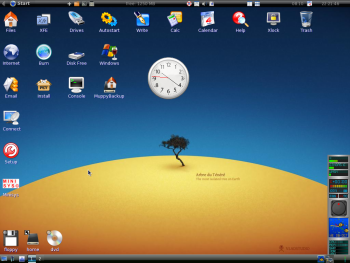Author: Dmitri Popov
Puppy Linux makes it easy to remaster its distribution, which probably explains the sheer number of Puppy Linux variants, called puplets, in the wild. Some of these puplets differ from the original only in offering different software bundles or use different window managers, while others target specific hardware platforms (for example, Pupeee). Minisys Linux, or Muppy, is an interesting puplet in the form of a modular Linux distro based on a Puppy Linux and Slackware 12 mix.
Unlike Puppy Linux, which is available in a single 96MB edition, Minisys Linux comes in four versions: Live, Mini, Server, and Embryo. The Live version uses 690MB and is stocked to the gills with applications for every task imaginable. The Seamonkey browser suite, Sylpheed email client, and Pidgin IM applications cover Internet needs, while OpenOffice.org, AbiWord, Gnumeric, and Adobe Acrobat Reader cater for office use. The multimedia section includes the MPlayer media player, XMMS audio player, and Goggles DVD player. The GIMP, MtPaint, and Gqview come in handy when you need to view or edit graphics, Wine helps you run Windows-based applications, and Minisys Linux also comes with a few games.
The Mini version, by contrast, takes just 128MB and comes with just a few essential tools and applications. However, you can expand the Mini version using extensions from Minisys Linux’s Web site — .sfs packs that can be added easily to the base system. The site provides Office, Games, Addons, and Development packs as well as extensions that add alternative desktop environments such as KDE and Enlightenment.
Server and Embryo are specialized versions of Muppy Linux. As the name suggests, the Server edition is designed for use as a server system, while Embryo is a bare-bones system suitable for the creation of memory-optimized, customized special solutions.
When you boot the Live or Mini edition, you’ll immediately notice how lavish the desktop looks compared to Puppy Linux. The Conky system monitor is installed by default, and it provides an overview of the system’s statistics, as does the custom Icedock applet, but using graphics instead of text. The Desktop also reveals a few useful tools not found in Puppy Linux. The MuppyBackup application, for example, allows you to quickly back up and restore your system, while the Autostart utility can be used to make specific applications start on boot. To do this, drag an application onto the Autostart icon, and the utility automatically generates a startup script.
Minisys Linux comes with two file managers: the lightweight PCman and the twin-panel Xfe. In addition, Minisys Linux sports Muppy-Filer, a no-frills twin-panel custom file manager. It may seem superfluous, but Muppy-Filer is a surprisingly functional and useful tool for light file managing tasks. Osmo, Puppy Linux’s default calendaring tool, has been replaced in Minisys Linux by the lcal utility, and clicking on the Internet icon launches the Opera browser instead of Seamonkey.
Minisys’s Start menu sports a launcher panel, where all installed applications are grouped by section, making it easier to locate and launch the application you want. Similar to Puppy Linux, you can use the PET package manager to install .pet packages, but Minisys Linux also allows you to install software from Slackware repositories using the Gslapt package management tool.
Minisys Linux comes with Puppy Linux’s excellent configuration wizard, which can help you configure essential settings such as keyboard layout, sound, video, wired and wireless network interfaces, printers, and firewall. The included Puppy Universal Installer tool lets you install Minisys Linux a variety of ways on various devices, including external hard disks and USB sticks.
In the Puppy Linux manner, all your data and system preferences are stored in a separate .2sf file which the system prompts you to create during the first shutdown. Creating the .2sf file allows you not only to save all your settings and data, but also extend the system using .sfs packs. Installing an extension in Minisys Linux is straightforward. Download the .sfs extension you want, move it to the /mnt/home directory, choose Start -> System -> Boot Manager, and press the “Choose which extra SFS files to load at bootup” button. Add the downloaded .sfs file and make sure that the “Ignore above user selection” check box is unticked. Reboot the system to enable the extension.
The current version of Minisys Linux is based on Puppy 3 and the 2.6.21.7 kernel, but Mark Ulrich, the lead developer, is already working on a new version of Muppy based on the latest Puppy Linux 4.1.
Although Minisys Linux takes Puppy Linux in a different direction, it does so in a clever and gentle manner. Minisys Linux preserves the best traits of its progenitor, such as user-friendly configuration and installation wizards and the PET package manager, and it adds a few nifty applications and features of its own. The killer feature of Minisys Linux is the ability to customize the system using .sfs packs, which allow you to set up a system that suits your needs in a matter of minutes.
Categories:
- Minisys
- Reviews
- Linux
- Distributions



